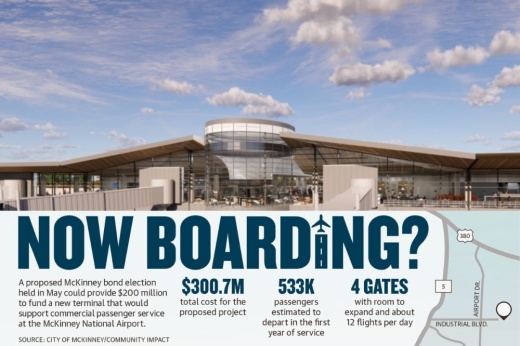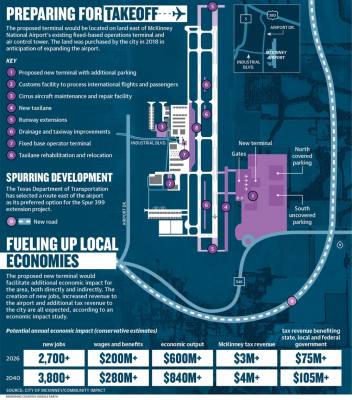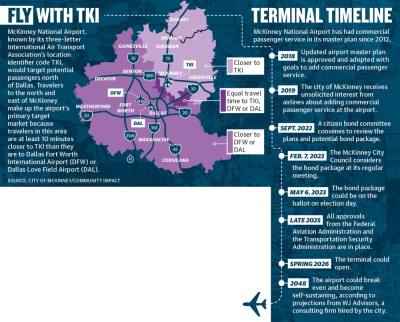McKinney City Council is considering a $200 million bond item to be added to the May election ballot at its Feb. 7 meeting. The single-item bond could fund an expansion project that would add a new terminal and commercial passenger service.
Five subcommittees representing members of the community, local government, representatives from other cities and third-party aviation experts met three times throughout October and November to discuss the potential expansion. The project would entail constructing a new terminal and parking lots as well as infrastructure improvements and a new taxiway. The Texas Department of Transportation’s Spur 399 extension project could also run parallel to the east side of the airport, based on TxDOT recommendations, and create an additional roadway to support the expansion.
“There’s tremendous economic impact and benefit to the city and the region,” McKinney Mayor George Fuller said. “You’re talking thousands of jobs, and you’re talking probably a billion dollars in economic annual impact.”
The project would cost $300.7 million in total, but the bond committee intends to ask McKinney voters for $200 million. The city anticipates between $60 million and $100 million in additional funding from federal sources to bridge the gap. The project, if approved by voters, could be operational as soon as spring 2026.
Adding commercial passenger service
McKinney leaders presented plans for a proposed terminal that would bring in commercial airlines for passenger services at the committee’s first meeting on Oct. 12.
The proposed terminal would be 144,000 square feet and include four gates with room to grow to 16 gates and 2,000 parking spaces as well as include dining, retail and enhanced passenger amenities, such as play areas for children near gates, according to the presentation. Curating a convenient experience was a goal of the design team, which included members of both City Council and city staff, Assistant City Manager Barry Shelton said.
The initial four-gate terminal could see between four and 20 commercial flight departures per day, according to initial demand forecasts. If approved, the project could begin the three years of construction needed in 2023.
McKinney National Airport provides general aviation services, such as private business flights, flight training and medical transport. The airport has been undergoing various expansion projects for some time, and it continues to operate at 100% occupancy, all while operating on its own revenues.
Commercial service has been in the airport’s master plan since 2012, Shelton said. After voters turned down a $50 million bond proposition to fund the airport in 2015, city officials found other ways to expand, including using property tax and sales tax dollars, generating revenue from fuel sales, and leasing hangar and office spaces.
Brian Loughmiller, McKinney Economic Development Corp. board chair, serves on the executive committee for the airport bond committee and said the proposed proposition will be different from 2015. During that election there were seven bond proposals totaling $160.3 million, said Loughmiller, who was also the city’s mayor during that period. Five of the seven proposals passed, with the exceptions being the airport improvements and $10 million for downtown parking. He said the proposition for the airport failed because it was not specific enough.
“We didn’t identify specific projects like we did with some of the road projects that we identified and other things that did pass,” he said. “In the past there wasn’t a lot of promotion for what the airport could be. ... There’s got to be an education to the public as to why this [current bond proposal] makes sense.”
This proposed proposition is more specific and tied to the single project, Loughmiller said.
The city began looking into the project after receiving unsolicited interest from commercial airlines to add passenger service at the airport in 2019, Shelton said. The city then hired consultants to look into demand and airline interest to see whether it is a viable option. Since then, the city has discussed the potential of commercial passenger service with various airlines.
“We’re talking about the whole range [of carriers], so we’re not limiting ourselves. Of course, we would like to have a mix so that we have something for all passengers,” Shelton said.
Funding airport expansions
The project is eligible for “considerable” grant funding through the Federal Aviation Administration, McKinney National Airport Director Ken Carley said at a committee meeting.
Projections presented in the bond committee meetings by Adam Giombetti, a consultant from WJ Advisors hired by the city to provide insight into aviation project financing, noted that, assuming a 5% interest rate and a 30-year repayment term, the project would likely break even in 2048 and become self-sustaining after that.
Estimates included in an economic impact study completed by Intervistas Consulting Inc. indicated the output for the first year of operations once the terminal opens could range between $600 million-$850 million, with the former figure representing a conservative estimate, Shelton said.
“We have a very successful airport today, so I think we’ve been able to look at this prospect very objectively, because we’re not desperate for cash flow,” Carley said.
The proposed bond would initially be paid off through city taxes, with the potential to be refinanced later on, McKinney Chief Financial Officer Mark Holloway said.
The city does not expect to raise the debt service portion of the city’s tax rate, which includes property taxes, if the bond passes, Holloway said.
“We can issue the debt, if approved by the voters, to build the terminal without first raising the tax rate, and secondly, without hindering our ability to further lower our tax rate over time,” Shelton said.
Additionally, by drawing travelers from across Dallas-Fort Worth as well as portions of southern Oklahoma in the airport’s target area defined in the demand analysis, the airport would provide an “economic boost” both through jobs and money spent by visitors, Shelton said.
Despite the city’s financial capabilities, the concept of “off-ramps” was built into the plan to allow for council and staff to stop the project process if needed, city leaders said. Shelton noted the results of the analyses and airline interest could have led to an off-ramp had their outlooks not been so positive.
The process could stall if the bond does not pass city council or voters, or if other factors emerge, such as economic instability. The city also anticipates having an environmental impact study back later this year, and results will also influence airport plans, Shelton said.
Fuller said a number of things could deter the project even if a bond is passed by voters. If further analysis found that the airport would gridlock the city with traffic or cause too much noise—all concerns brought up by the bond committee—he would no longer want the project to move forward, he said.
“It’s important to acknowledge that although we’re taking steps forward towards our ability to add commercial service, none of these—even a bond election—means that we will add commercial service,” Fuller said.
Supporting regional transportation
If approved, the McKinney National Airport would be the third commercial passenger airport in the North Texas area, joining Dallas Fort Worth International Airport and Dallas Love Field Airport. Airlines operating in the area all expect to have a third airport join the two existing North Texas airports to service the region, City Manager Paul Grimes said.
Edward Shelswell-White, the chief customer officer of SkyEnergy, an aviation consulting firm, said Dallas Love Field Airport is federally limited to 20 gates, which it has. DFW Airport is restricted by its runway space and the number of operations it can handle per hour, he said.
“The ability to have a third airport increases the overall capacity and access to air transportation for people who live in the Collin and Denton county areas, and even north of there, frankly. Places farther outlying it would become basically their closest, most convenient airport,” Shelswell-White said.
Study estimates reflect that demand, predicting 533,000 passengers could depart from McKinney National Airport in the first year of commercial passenger service. The study did not include estimates for arrivals.
If the bond is not approved by city council or voters, the airport would remain a general aviation airport and continue its existing operations, Shelton said. The airport as it stands today generates about $3.5 million in annual ad valorem tax revenue, Carley said.
Loughmiller said the city is taking a proactive approach to the growth of McKinney by looking so closely at the project.
“We do have interest now from airlines. We do have the capacity and the land to build it; it’s just the next step in the evolution of McKinney,” he said.
Editor's note: The original post has been edited to clarify that the airport generates $3.5 million in total annual ad valorem tax revenue.








